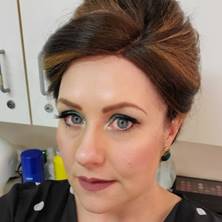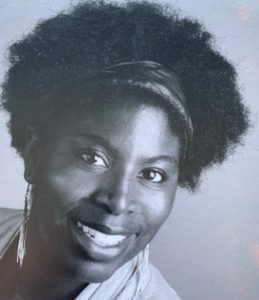“You look MAHvelous!” – Billy Crystal (as Fernando Lamas) Saturday Night Live
In our society, one of the key aspects to looking and feeling good is taking particular care of your hair and makeup. Theatre hair styling and makeup on the other hand, serve to delineate and enhance the essence and personality of a character and to give performers an additional tool for bringing those to life.
Today, we are speaking with Sondra Rogers who has worked on over 30 OLT productions, most notably on hair and makeup design. The makeup designer is responsible for creating the visual appearance of any makeup worn by the actors. The makeup designer works closely with the costume designer to create a look for each actor that will visually support the character.
Sondra was responsible for helping transport the audiences of Guess Who’s Coming to Dinner back to the Groovy Sixties with its unique sense of style and fashion.
While working together on the set of Gaslight, Sondra and I were sitting in the Green Room “on call” for either the next prop change (in my case) or the next hair and makeup touch up (in hers). At a recent VOLT meeting (OLT Volunteer Committee), her name had come up as one of our leading designers in her field, and I thought what a great opportunity to reach out to her to recount her experiences and share insights on her craft. So away we go.
What do you do for a living?
Sometimes I do freelance makeup but my main work experience has been Admin. I also worked in a hair salon for about two years.
How did you become involved with the OLT?
I became involved with OLT in 2010. At the time I had finished a casual position with the Department of Justice and wanted to do something that I really enjoyed. In high school, I was really involved in drama and would help out sometimes with makeup backstage. This led me to think, in 2010, why not start doing makeup? I emailed some of the theatres in Ottawa to volunteer and I happened to get a response that I might be needed to assist on OLT’s Halloween production Honeymoon at Graveside Manor. And that was how I started.
What have you done for OLT?
I mostly have done hair and makeup, but have helped out with costumes, and did one stint as AD.
How do you get the gig? Does the play director contact you or do you call them?
Usually it’s just word of mouth. In my case, somebody might just verbally ask me or email me.
What is the process for deciding what to do for hair and makeup? Are there any pointers from the script?
I like to read the script first and get a sense of the personality of the characters and in what period the play takes place.
What type of research has to be done for period pieces?
To research makeup and hair, I like to research online and go to the library for reference. I look at the styles of whatever time the play takes place. Portraits, paintings, magazines – all are great for inspiration.

Amy Kennedy in OLT’s production of Guess Who’s Coming to Dinner. Period hair and makeup designed by Sondra Rogers (photo by Maria Vartanova)
Do you consult with the actors and director?
Yes. I’ll consult with the director first and then the actors. I’ll demonstrate a few images I’ve collected to give them a sense of what we might be looking for.
How long does it take to do one actor’s hair and makeup?
It depends. If it’s a period piece that involves wigs or special effects, then it can take about an hour.
How do you handle big casts? When do you call in help?
For big casts, I usually will call in other volunteers who are available to help out. It makes it so much easier! I try to contact people about a month or so ahead. Once I have a confirmed team together, I try to be mindful of their availability and will make up a schedule. I also try to teach the actors how to do some things on their own as well, so they can be self-sufficient if someone isn’t available.
How far in advance of curtain-up do you begin work?
Again it depends on the play. Usually an hour or so before curtain.
What was the biggest challenge regarding hair and makeup?
I guess the biggest challenge for me, regarding hair and makeup, is getting the look right. Is this style going to work on an actor’s hair, or does this makeup look close to the period? Another challenge can be finding available people to volunteer to help with hair and makeup. Everyone is busy, so sometimes it’s hard to find people to stick with it. I’ve been really fortunate that I’ve had great people helping me out with several recent shows.
Any interesting stories/anecdotes about past plays or Guess Who’s Coming to Dinner?
I don’t really have any particular stories that come to mind. However, all of the plays I have worked on have been so much fun. The thing about doing hair and makeup is that I get to be in the thick of it with the actors in the dressing room. I see their anxiety, I listen to them run their lines, and I’m there for the laughter, and sometimes the tears. It’s wonderful to see everything all come together when they perform.
Any message you would like to give the readers?
I guess the only message I can give is that it takes a lot for each performance to come together. Everyone puts so much into it over three months of their own time. The OLT is such an amazing community. It’s addictive! It’s also a great way to immerse yourself in an interest you may have, whether it’s sound, lighting or in my case, makeup and hair. You can learn so much and sometimes it challenges you to come up with creative ideas to make something work.
-Albert

